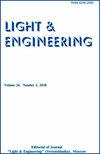Translucent Skylights from Falconnier Glass Blocks
IF 0.3
4区 工程技术
Q4 ENGINEERING, ELECTRICAL & ELECTRONIC
引用次数: 0
Abstract
Construction technologies go through several stages: emergence, improvement, decline and revival. Falconnier glass block technology, which was in demand at the very beginning of the 20th century, is now being revived again. Hand-blown and hollow inside, Falconnier glass blocks were widely used for glazing windows, greenhouses, lighting stairs, but of particular interest is their use as a material for glazing translucent coatings of roofs and atriums. Quite often, glass bricks could be found in blank fire walls. In most cases, glass blocks were used for the purpose of zoning spaces while maintaining daylighting, as well as in technical rooms. But Falconnier glass blocks were also used for glazing front facades. But in the mansion of the Tambov manufacturer Aseev, built in 1904–06, a unique cylindrical vault was made from this material, covering the large span of the central living room. On the territory of Russia, it was apparently the only structure of complex configuration made of Falconnier glass blocks. The structure was lost and needs to be restored. According to the results of research, its close analogue is the translucent coating of the atrium of the town hall in Zurich, which is perfectly preserved and, in fact, is very close to the historical design of the lost part of the skylight in M.V. Aseev’s mansion. At the moment, there is every reason to believe that the lost Falconnier technology was practically restored by enthusiasts, which will expand the possibilities in the field of restoration of monuments at the turn of the 19th‑20th centuries. Both of these factors – the existence of a similar constructive solution and the restored technology for manufacturing glass blocks – open up opportunities for recreating a glass barrel vault that completes the atrium of M.V. Aseev’s mansion, which is currently a museum complex.Falconnier玻璃体的半透明天窗
建筑技术经历了出现、发展、衰落和复兴的几个阶段。20世纪初风靡一时的Falconnier玻璃砌块技术,如今又重新焕发了生机。手工吹制的Falconnier玻璃砌块内部中空,被广泛用于玻璃窗、温室、楼梯照明,但特别有趣的是,它们被用作屋顶和中庭半透明涂层的玻璃材料。通常,在空白的防火墙上可以找到玻璃砖。在大多数情况下,玻璃块用于分区空间的目的,同时保持采光,以及在技术房间。但Falconnier玻璃块也用于玻璃立面。但在坦波夫制造商阿西耶夫(Aseev)建于1904-06年的豪宅中,一个独特的圆柱形拱顶是用这种材料制成的,覆盖了中央客厅的大跨度。在俄罗斯境内,它显然是唯一一个由Falconnier玻璃块制成的复杂结构。该建筑已经丢失,需要修复。根据研究结果,它的类似物是苏黎世市政厅中庭的半透明涂层,它保存完好,实际上非常接近M.V. Aseev豪宅中丢失的部分天窗的历史设计。目前,有充分的理由相信,失去的法尔科尼耶技术实际上是由爱好者修复的,这将扩大19 - 20世纪之交古迹修复领域的可能性。这两个因素——类似的建设性解决方案的存在和制造玻璃块的修复技术——为重建玻璃桶拱顶提供了机会,该拱顶完成了M.V. Aseev豪宅的中庭,该豪宅目前是一个博物馆综合体。
本文章由计算机程序翻译,如有差异,请以英文原文为准。
求助全文
约1分钟内获得全文
求助全文
来源期刊

Light & Engineering
ENGINEERING, ELECTRICAL & ELECTRONIC-OPTICS
CiteScore
1.00
自引率
50.00%
发文量
0
审稿时长
1 months
期刊介绍:
Our magazine
develops comprehensive communication within the lighting community, providing opportunities for discussion and free expression of opinions of specialists of different profiles;
contributes to the convergence of science and engineering practice, the search for opportunities for the application of research results in lighting and technological applications of light;
keeps the scientific community up to date with the latest advances in the theory of the light field, providing readers with operational professional information;
initiates international cooperation, promotes and distributes the results of Russian authors in the international professional community;
provides equal opportunities for authors from different regions of Russia and other countries.
The journal publishes articles in the following areas:
visual and non-visual effects of radiation on humans;
light field theory;
photometry and colorimetry;
sources of light;
ballasts;
light devices, their design and production technology;
lighting and irradiation installation;
light signaling;
methods of mathematical modeling of light devices and installations;
problems of energy saving in lighting, installation and operation of lighting installations;
modern production technologies of lighting products for lighting control systems;
innovative design solutions;
innovations in lighting and lighting design;
the study of the effect on plants and animals, problems of using light in medicine;
problems of disinfection of premises, water and smell elimination with the help of technology of UV radiation using;
problems of light in the ocean and space.
 求助内容:
求助内容: 应助结果提醒方式:
应助结果提醒方式:


